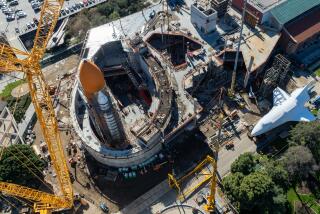Atlantis Poised for Complex Space Odyssey : Shuttle: It will circle Earth with a satellite on the end of a 12.5-mile-long tether. The device may be a source of electrical power for future space stations.
- Share via
KENNEDY SPACE CENTER, Fla. — Poised for its 12th launching since joining the U.S. space fleet, the shuttle Atlantis is to set out Friday on perhaps the most complex mission flown since the United States began orbiting its aerospace planes more than a decade ago.
The planned seven-day odyssey foresees none of the spacewalking heroics that marked the satellite retrieval by astronauts on the shuttle Endeavour in May, but lead flight controller Charles W. Shaw predicts that the upcoming flight will “usher in a new way of doing business in Earth orbit.”
For 10 1/2 hours, Atlantis is to circle the Earth with a 1,150-pound satellite on the end of a 12.5-mile-long tether.
Visionaries see the experiment as the harbinger of a day when tethered devices provide electrical power for space stations, retrieve soil samples from the surface of Mars, or explore lower fringes of space inaccessible to high-flying balloons, aircraft and orbiting vehicles.
Besides sending out and reeling in the satellite developed by the Italian space agency, the six-man, one-woman Atlantis crew will deploy an automated mini-space station for the European Space Agency. EURECA, as the laboratory is called, is to be recovered and returned to Earth when Atlantis makes its next trip into space in April, 1993.
Launch crews Wednesday marched through the complex countdown begun on Tuesday. Barring unforeseen problems, Atlantis is to lift off at 6:56 a.m. PDT Friday. Weather forecasters predicted nearly ideal conditions at the scheduled liftoff time.
The flight commander will be Air Force Col. Loren J. Shriver, a veteran of two previous missions, and the pilot will be Marine Corps Maj. Andy Allen, who is making his first space flight.
The rest of the crew for the 49th shuttle flight is made up of civilian mission specialists Claude Nicollier and Marsha Evans, also newcomers to space flight, and Jeff Hoffman, Franklin Chang-Diaz and Franco Malerba, all shuttle veterans. Nicollier is an employee of the European Space Agency, and Malerba of the Italian agency.
Preparation for the flight has been extensive, especially after the harrowing and unexpected struggle to recover the errant communications satellite during the May shuttle mission. NASA administrator Daniel S. Goldin has ordered an additional safety review of the flight plan before giving the mission final clearance. “On a scale of zero to 10, preparation for this flight has been about a 30,” Shaw recently told reporters.
Although planners consider the possibility of losing control of the Tethered Satellite extremely remote, the Atlantis crew has carefully worked out procedures for cutting the tether and moving the orbiter away from it. Thirty hours will elapse between the time the Tethered Satellite is lifted from the Atlantis cargo bay until it is reeled in and secured for the return to Earth.
The operation will occur after launch of the EURECA laboratory, which means the mission specialists will be working around the clock in two separate shifts.
The 9,000-pound laboratory, to be operated by the European Space Agency’s control center in Darmstadt, Germany, will enable scientists to conduct extraordinarily precise microgravity experiments.
Unlike such work performed aboard the shuttle, the experiments in EURECA’s seven compartments will not be affected by orbital maneuvers or the movement of crew members. Once it has left the shuttle, the laboratory will be boosted upward to an altitude of about 310 miles, where it will operate until it is lowered to about 180 miles in preparation for its retrieval by astronauts next year. As soon as the European payload is delivered, the Atlantis crew will prepare to send the Tethered Satellite slowly upward from the cargo bay. The five-foot-diameter satellite will be released from a boom extending 40 feet above the orbiter, then moved away by tiny thrusters, reaching its maximum distance of 12.5 miles in 5 1/2 hours.
More to Read
Sign up for Essential California
The most important California stories and recommendations in your inbox every morning.
You may occasionally receive promotional content from the Los Angeles Times.












